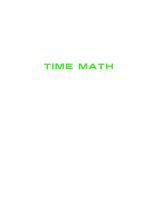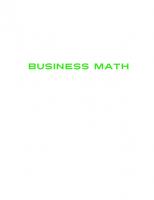Time math 9781422229019, 1422229017, 9781422229101, 1422229106
228 88 3MB
English Pages [50] Year 2014
Title Page
Contents
Introduction
Chapter 1: Time Conversion
Chapter 2: Time Fractions
Chapter 3: Future Time
Chapter 4: Past Time
Chapter 5: Time Patterns
Chapter 6: Being On Time
Chapter 7: Alarms
Chapter 8: Stopwatches
Chapter 9: Calendar Math
Chapter 10: Timelines
Chapter 11: Military Time
Chapter 12: Roman Numerals
Chapter 13: Time Zones
Chapter 14: Time Zone Travel
Chapter 15: Putting It All Together
Find Out More In Books
Find Out More on the Internet
Glossary
Answers
Index
About the Author
Picture Credits
Blank Page
Recommend Papers

- Author / Uploaded
- James Fischer
File loading please wait...
Citation preview
NHMC13_10HBK_Math24-7_NHMC13_Math24-7 5/15/13 8:58 AM Page 8
We live our lives according to the numbers on a clock. Whether it’s getting to school on time, allowing enough time in a day for the things we need to do, or timing an activity, those numbers are an important part of almost everything we do. Time Math will help you understand schedules and timetables. You’ll be able to better manage the math that runs our clocks!
BE SURE TO READ OTHER BOOKS IN THIS SERIES
ISBN 978-1-4222-2910-1
90000
EAN
Cover image: Shutterstock.com
9 781422 229101
Time Math
Math 24/7 Banking Math Business Math Computer Math Culinary Math Fashion Math Game Math Shopping Math Sports Math Time Math Travel Math
Math 24/7 Time Math James Fischer
Mason Crest
Mason Crest 450 Parkway Drive, Suite D Broomall, PA 19008 www.masoncrest.com Copyright © 2014 by Mason Crest, an imprint of National Highlights, Inc. All rights reserved. No part of this publication may be reproduced or transmitted in any form or by any means, electronic or mechanical, including photocopying, recording, taping or any information storage and retrieval system, without permission from the publisher. Printed in the United States of America. First printing 987654321 Series ISBN: 978-1-4222-2901-9 ISBN: 978-1-4222-2910-1 ebook ISBN: 978-1-4222-8921-1 The Library of Congress has cataloged the hardcopy format(s) as follows: Library of Congress Cataloging-in-Publication Data Fischer, James. Time math / James Fischer. pages cm – (Math 24/7) Includes bibliographical references and index. ISBN 978-1-4222-2910-1 (hardcover) – ISBN 978-1-4222-2901-9 (series) – ISBN 978-1-4222-8921-1 (ebook) 1. Time–Juvenile literature. I. Title. QB209.5.F57 2014 529–dc23 2013015669 Produced by Vestal Creative Services. www.vestalcreative.com
Contents Introduction 6 1. Time Conversion 8 2. Time Fractions 10 3. Future Time 12 4. Past Time 14 5. Time Patterns 16 6. Being On Time 18 7. Alarms 20 8. Stopwatches 22 9. Calendar Math 24 10. Timelines 26 11. Military Time 28 12. Roman Numerals 30 13. Time Zones 32 14. Times Zone Travel 34 15. Putting It All Together 36 Find Out More 38 Glossary 40 Answers 41 Index 46 About the Author 47 Picture Credits 48
Introduction
H
ow would you define math? It’s not as easy as you might think. We know math has to do with numbers. We often think of it as a part, if not the basis, for the sciences, especially natural science, engineering, and medicine. When we think of math, most of us imagine equations and blackboards, formulas and textbooks. But math is actually far bigger than that. Think about examples like Polykleitos, the fifth-century Greek sculptor, who used math to sculpt the “perfect” male nude. Or remember Leonardo da Vinci? He used geometry—what he called “golden rectangles,” rectangles whose dimensions were visually pleasing—to create his famous Mona Lisa. Math and art? Yes, exactly! Mathematics is essential to disciplines as diverse as medicine and the fine arts. Counting, calculation, measurement, and the study of shapes and the motions of physical objects: all these are woven into music and games, science and architecture. In fact, math developed out of everyday necessity, as a way to talk about the world around us. Math gives us a way to perceive the real world—and then allows us to manipulate the world in practical ways. For example, as soon as two people come together to build something, they need a language to talk about the materials they’ll be working with and the object that they would like to build. Imagine trying to build something—anything—without a ruler, without any way of telling someone else a measurement, or even without being able to communicate what the thing will look like when it’s done! The truth is: We use math every day, even when we don’t realize that we are. We use it when we go shopping, when we play sports, when we look at the clock, when we travel, when we run a business, and even when we cook. Whether we realize it or not, we use it in countless other ordinary activities as well. Math is pretty much a 24/7 activity! And yet lots of us think we hate math. We imagine math as the practice of dusty, old college professors writing out calculations endlessly. We have this idea in our heads that math has nothing to do with real life, and we tell ourselves that it’s something we don’t need to worry about outside of math class, out there in the real world. But here’s the reality: Math helps us do better in many areas of life. Adults who don’t understand basic math applications run into lots of problems. The Federal Reserve, for example, found that people who went bankrupt had an average of one and a half times more debt than their income—in other words, if they were making $24,000 per year, they had an average debt of $36,000. There’s a basic subtraction problem there that should have told them they were in trouble long before they had to file for bankruptcy!
6
As an adult, your career—whatever it is—will depend in part on your ability to calculate mathematically. Without math skills, you won’t be able to become a scientist or a nurse, an engineer or a computer specialist. You won’t be able to get a business degree—or work as a waitress, a construction worker, or at a checkout counter. Every kind of sport requires math too. From scoring to strategy, you need to understand math—so whether you want to watch a football game on television or become a first-class athlete yourself, math skills will improve your experience. And then there’s the world of computers. All businesses today—from farmers to factories, from restaurants to hair salons—have at least one computer. Gigabytes, data, spreadsheets, and programming all require math comprehension. Sure, there are a lot of automated math functions you can use on your computer, but you need to be able to understand how to use them, and you need to be able to understand the results. This kind of math is a skill we realize we need only when we are in a situation where we are required to do a quick calculation. Then we sometimes end up scratching our heads, not quite sure how to apply the math we learned in school to the real-life scenario. The books in this series will give you practice applying math to real-life situations, so that you can be ahead of the game. They’ll get you started—but to learn more, you’ll have to pay attention in math class and do your homework. There’s no way around that. But for the rest of your life—pretty much 24/7—you’ll be glad you did!
7
1
Time Conversion
S
onia has been thinking about time a lot lately. She just got a cell phone, so she can check the time whenever she wants. Every time she gets her phone out, she looks at the time. And every day she frequently looks at the clock in class, to see how much longer is left until school is over. It’s almost summer break, and she’s ready to play sports, go on vacation, and hang out with her family and friends. Sonia has a countdown till summer break that’s running on her computer at home. It counts down in both days, hours, and minutes, and also in just minutes. Looking at just the minutes makes it seem like summer is really long away, but looking at the days makes it shorter. Check out the next page to see how Sonia’s countdown converts minutes to days and hours.
8
An hour is made up of 60 minutes, and a minute is made up of 60 seconds—easy enough. But what happens when you want to figure out how many minutes are in 5 hours, or 9 hours and 23 minutes. What if you wanted to find out how many seconds made up that time? It’s pretty simple to convert between hours and minutes (or minutes and seconds). If you know the number of hours, just multiply it by 60. 1. How many minutes are in 3 hours? If there are extra minutes in addition to the hours, just multiply the hours and add on the minutes to your answer. 2. How many minutes are in 3 hours and 56 minutes? To find how many hours are contained in a certain number of minutes, divide by 60. 3. How many hours are in 480 minutes? The tricky part is when you have a remainder when you divide the hours by 60. Let’s say you are looking at 515 minutes. When you divide 515 by 60, you get 8.58. How many minutes are in .58 hours? Once you have divided the minutes by 60 and seen there is a remainder, next figure out how many minutes are in the number of hours in the ones’ place. Then subtract that from the number of total minutes. What is left is the number of extra minutes past the hour: 515 minutes in 8.58 hours – 480 minutes in 8 hours = 35 minutes So, 515 minutes = 8 hours 35 minutes 4. How many hours and extra minutes are in 171 minutes? 5. If Sonia has 2 days, 7 hours, and 46 minutes left until summer break, how many minutes is that? Remember, there are 24 hours in a day.
9
2
S
Time Fractions
onia is talking to her friends about their after-school plans that day. She wants to go hang out in the park, but she has to meet with a teacher right after school. “It’ll only take half an hour,” she says. Her friend Jackson points out that the teacher she’s meeting with really likes to talk. He says, “I think it will be more like three-quarters of an hour.” Sonia agrees and suggests they all meet up at the park at a quarter past four, just to be sure she’ll have enough time to meet with her teacher and then get to the park. Sonia and her friends are talking about time in terms of fractions. Just like with anything else, parts of an hour can be expressed in fractions. Do some practice on the next page.
10
Most people memorize the common fractions we use for time: one-quarter (1/4) hour = 15 minutes half (1/2) an hour = 30 minutes three-quarters (3/4) of an hour = 45 minutes 1. What time are Sonia and her friends meeting if they plan to arrive at quarter after 4? You can also figure out how many minutes are in fractions of an hour using math. All you need to do is divide the number of minutes in an hour by the denominator. Then multiply that number by the numerator. To find three-quarters of an hour: ¾ of an hour = (60 minutes ÷ 4) x 3 ¾ of an hour = 45 minutes 2. What is two-quarters of an hour using math? What else could you say instead of twoquarters of an hour? You can use this method to come up with fractions of time we don’t commonly use, like a fifth of an hour or two-thirds of an hour. 3. What is one-fifth of an hour? 4. What is two-thirds of an hour? Hours aren’t the only unit of time you can divide into fractions. You can also talk about minutes, days, weeks, months, years, and even centuries in fractions. Try finding the following fractions of time: 5. three-quarters of a week (in days) = one-half of a minute (in seconds) = four-fifths of a 30-day month (in days) = seven-twelfths of a year (in months) = one-quarter of a century (in years) =
11
3
A
Future Time
fter school, Sonia and her friends meet up at quarter after four and hang out in the park. After a little while, Jackson mentions to everyone that he has to leave in a couple hours to go visit his grandparents. Sonia and Megan also need to go home to finish a little bit of studying they have left before the end of the school year. They have a test tomorrow, and they want to make sure they do well. How much time do the friends have left to hang out? How much time will they need to study and sleep? And how much time is left before Sonia and Megan’s test? Figure it out with time addition. Sonia and her friends start talking about time at 4:35. Jackson will have to leave in an hour and a half to get home in time to visit his grandparents. What time will Jackson have to leave? You can do addition with time just like with any other number.
12
First, you will need to convert an hour and a half into time. An hour and a half is like saying 1:30. So: 4:35 + 1:30 = 5:65 Since there are only 60 minutes in an hour, you need to carry the extra 5 minutes into another hour. You can express the 60 as 00, the beginning of a new hour, so 5:65 becomes 6:05. 1. It takes Jackson about 40 minutes to get to his grandparents’ house. What time will he get there if he and his family leave his house at 6:30? Sonia and Megan both want to be home by 6:30 to have dinner and do some studying. Megan lives right next to the park, so she can leave at 6:30. Sonia lives a little further away than Megan, so she has to leave 10 minutes earlier. How much longer do both girls have to hang out at the park? These problems need subtraction. You know what time they need to be home, but you don’t know how much time they have until then. Megan will leave at 6:30, and it is 4:35 now. Set up the subtraction problem like usual. But remember, there are only 60 minutes in an hour. 6:30 – 4:35 = 1:55 In other words, Megan has an hour and 55 minutes before she needs to leave the park. To find how much longer Sonia has at the park, you can do another subtraction problem using 6:20 (10 minutes earlier than Megan), or you can just subtract 10 minutes from the time Megan has left at the park. 2. How much time is there before Sonia has to leave if it is 4:35 now?
13
4
Past Time
W
hen Sonia goes home, she eats dinner and starts to study for her math test, which is tomorrow. She thinks about all the time she has spent studying for this test, and for other math tests throughout the year. She wonders just how much time she has spent on math! She wants to add it all up, but figuring how much time she has spent studying will also take some subtraction. See how Sonia does it on the next page.
14
First, Sonia makes a list of all the time she has spent studying for the last few tests: Test #1 Monday: half an hour Tuesday: one hour Wednesday: two hours and 15 minutes Test #2: Saturday: 45 minutes Sunday: two hours Monday: one hour and 20 minutes Test #3 Thursday: 4:00–5:30 Saturday: 1:15–3:00 Sunday: 7:00–7:30 Monday: 7:00–9:15 1. How many hours did Sonia spend studying for each test? 2. What are those three amounts in minute-only form? Sonia can’t remember how much she studied for the tests before these three. She does know she has had 15 tests in math throughout the year. Even though she doesn’t know the exact number of hours she studied for all her tests, she can find the average number of hours she studied for these three tests. Once she finds the average, she can multiply it by the number of tests she has taken to approximate just how many hours she has spent studying in total. First, find the average number of hours she studied for these three. Add all the hours together and divide by the number of tests for which you counted hours. It’s easier to find the average in just minutes (rather than minutes and hours). 3. What is the average number of minutes she studied? Now multiply the average number of minutes she studied per test by the number of math tests she has taken all year. Your calculation will give you an estimate of how many minutes she studied all year for math. 4. How many minutes did she study? What is it in hours and minutes?
15
5
S
Time Patterns
onia usually takes the school bus to school, but once in a while she misses it. If that happens, there is also a public bus that stops by her corner. She can take that bus and transfer to another bus that will take her to school. She doesn’t like to miss the school bus, because taking the public bus is longer and more hassle. However, this morning, she misses her bus. On top of that, it’s the last day of school! She wants to be there to say goodbye to her friends and teachers, and get some of her assignments back. Sonia checks the public bus schedule. She has to look at two different schedules and line them up because she has to take two different buses. The buses come at regular intervals, so Sonia has to understand time patterns in order to get to school on time. Can she do it?
16
The school bus normally comes around 7:25. Sonia just missed it, and it is now 7:28. She checks the bus schedule times at the stops she needs and sees: Bus #1 7:18 7:28 7:38 7:48 7:58 8:08
Bus #2 7:15 7:29 7:45 7:59 8:15 8:29
1. How many minutes are between each Bus #1 arrival? 2. What is the pattern of Bus #2 arrivals in minutes? The first bus ride takes about 9 minutes. Then she will get off and wait for the next bus. The second bus ride to school takes about 7 minutes. Sonia has already missed the 7:18 bus and just missed the 7:28 Bus #1. She will have to take the 7:38. 3. What time will she get to the second bus stop if she gets on the first bus at 7:38? Will she make it to the 7:45 Bus #2? 4. Which Bus #2 will Sonia need to take? Sonia’s school day starts at 8:10. She normally gets there at 7:50 on her school bus, and has a few minutes to relax before school starts. 5. Will Sonia get to school on time considering the time she gets picked up by Bus #2? What time will she arrive? 6. How many minutes later is she than when she would normally get to school?
17
6
S
Being on Time
onia is tired of missing the bus and being late for other things. It seems like she’s always running late! This summer, she wants to practice being on time. When the next school year arrives, she will always be on time! On the first day of her summer vacation, Sonia has a dentist appointment. She isn’t very happy about it, but she decides the appointment is a good chance to practice being on time. Her dad, who is going to take her to her appointment, also tends to be late and has trouble getting places on time. Sonia thinks she’ll have to be the one to get them there on time. The next pages show some calculations she could do to help her be on time.
18
Sonia’s dentist appointment is at 3:30 in the afternoon. She knows it takes 20 minutes to get there. 1. What time do you think Sonia should leave to get to her dentist appointment? There are some other things to consider. She and her dad also have to fill out some paperwork at the dentist. She’s not sure how long that will take, but she thinks maybe 10 minutes. Also, there is some construction along the way to the dentist’s office. Sonia is also not sure how much longer it will take to get there, but she takes a guess of 15 minutes extra. 2. How many minutes do they need to add to get to the dentist on time? What time should they leave? Sonia almost forgets about her appointment, but she looks at her phone at 2:40 and remembers. She has to remind her dad and get ready to go. They are out the door by 2:46. 3. If the trip ends up taking 33 minutes, will they get there on time for the appointment, including filling out paperwork? If so, how much extra time do they have? If not, how late were they? From now on, Sonia will use a chart that looks like this. She has soccer camp next week, which starts at 9:00 AM on Monday, Wednesday, and Friday. On Tuesday and Thursday, it starts at 10:00 AM. It will take her 12 minutes to get there. Add those lines to the chart, as well as the information for the dentist appointment. Event
Day
Dentist Wednesday appointment Soccer camp Soccer camp
Time 3:30
How Long It Takes to Get There
Time Needed to Leave
19
7
Alarms
A
s part of Sonia’s plan to be on time, she wants to use alarms more often. During the school year, she uses an alarm clock to wake up every day for school, but she sometimes sleeps past the alarm. Sonia has an alarm on her new phone. She thinks she should use it to set alarms so she’s on time for things. She knows she might not always pay attention to just one alarm, though, so she’ll need to set multiple alarms to remind her to do things. See how she does it on the next pages.
20
One day next week, Sonia will have to use her alarm clock to get up. She’s going to an amusement park with her friend Marco. He and his family are picking her up at 8:30 in the morning, so she has to be up and ready to go by then. Sonia needs at least 45 minutes to get dressed, eat breakfast, and brush her teeth. 1. What is the earliest she can get up? She isn’t sure she’ll be able to get up with just one alarm, though. Her alarm clock has a snooze button. When her alarm goes off, she can press the snooze button, which will give her 7 more minutes of sleep. The alarm goes off after 7 minutes. Write down how many minutes she adds to her sleep by pressing snooze, and what time Sonia will get up. The first one has been done for you. 2. 0 snooze = 0 minutes, 7:45 1 snooze = 2 snooze = 3 snooze = 4 snooze = Sonia thinks she may hit the snooze button twice. 3. What time should she set the alarm for if she hits snooze twice? On the day of the trip, Sonia actually ends up hitting the snooze button 3 times and has to rush to get ready. 4. What time did she get up if she set the alarm thinking she would only hit snooze twice? How many minutes does she have to get ready?
21
8
Stopwatches
A
t the amusement park, Sonia and Marco have a great time. They ride roller coasters, play games, and eat pizza. Then they find the go-carts. The amusement park has a go-cart setup that allows customers to race. Every day they put up the fastest times for people to beat later in the day. Sonia and Marco watch for a while before they take a turn themselves. After a few minutes, they notice the times being posted for the races don’t seem to match the real times. Sonia uses the stopwatch on her phone to time how long it really takes the racers to finish. Once they figure it out, they’re ready to race too—and win!
22
The racers have to drive around the track 5 times. The top scores for the day are: 3 minutes 3 seconds 3 minutes 17 seconds 3 minutes 24 seconds 3 minutes 39 seconds 3 minutes 41 seconds 1. What is the difference between first place and fifth place? Once Sonia and Marco notice the times on the board don’t seem right, they check with their own stopwatch. The person who finishes first in this race gets a time of 3 minutes 3 seconds, so he move to first place on the board. However, the time they get is 4 minutes 53 seconds. 2. By how much is the amusement park stopwatch off? To be sure, they time another race. This time, the winner of the race gets 3 minutes 38 seconds on the board. They timed her getting 5 minutes 28 seconds. 3. Is the amusement park stopwatch off by the same amount? If not, how much was it off this time? Marco is going to race and see if he can beat the best score for the day. Sonia agrees to stand on the sidelines and keep an eye on the stopwatch. When it’s getting close to the actual time he needs to win, she’ll yell so he knows he’s running out of time. As Marco is about to drive his final lap, Sonia yells that the stopwatch says 2 minutes and 30 seconds. 4. What’s the average amount of time it has taken him to make 1 lap? 5. Will he beat the best score if his last lap takes the average amount of time the other laps have? What will his time be? If not, how far away from the top score will he be?
23
9
Calendar Math
S
onia is getting better and better at being on time. She still tends to forget about places she has to be that are days away, though, and she’s often late because she only remembers them at the last minute. For example, she forgot her friend Megan’s birthday last week until another friend called her and asked her if she was going, just a half hour before the party started. Looking at the calendar and using a planner might help Sonia. She can remind herself ahead of time that she needs to be somewhere. And she can use math to use her calendar, and remember important dates!
24
The next big thing Sonia has to remember is her dad’s birthday, which is on July 31. She wants to get him a card and a present, and she doesn’t want to forget. 1. How many days away is her dad’s birthday if today is July 26? She can write it in her calendar and then remind herself when her dad’s birthday is 2 days away. 2. How many days away does she have until she needs to remind herself about the birthday? Sonia also wants to make the most of her summer. She isn’t sure how many days are left of summer break, but having a calendar makes it easy. She can choose from a few ways to figure out how much time she has left during summer break. She could count out every single day on the calendar, but that will take a lot of time, and she might end up miscounting. She could count by week instead. That’s a lot easier than counting days. Then she can just multiply the number of weeks by 7 to figure out just how many days she has left. 3. If there are 5 weeks and 5 days until she goes back to school, how many days of summer does she have left? Sonia could also add up the number of days in the months she has left until school starts. Today is July 26. School starts on September 4. To add correctly, you need to know how many days there are in each month. Some have 30 and other have 31 (and one has 28). 28 days: February 30 days: April, June, September, November 31 days: January, March, May, July, August, October, December 4. Using this information, how many days does Sonia have until school starts?
25
10
Timelines
S
onia’s mom is putting together a family history. She is going through lots of old photos and letters, trying to figure out who is related to whom. Sonia helps out sometimes, because she thinks her family history is interesting. She finds it hard to keep track of everything, though, because there are so many documents and so many dates. She and her mom start putting together a timeline for their family. Every time they find a new piece of information, like when someone was born, they add it to the timeline. When they are finished, they will have a long timeline that lists the important things that have happened in the family. Check out the next page to see what a timeline looks like, and help them construct their family timeline.
26
Here are some of the pieces of information Sonia and her mom have discovered from 1900 to 1960: Great-grandmother born: September 30, 1908 Great-grandfather born: March 4, 1912 Grandmother born: 1941 Great-grandparents on father’s side came to America: 1927 Great-grandfather died: 1953 Mother’s family came to America: 1958 Grandfather on father’s side started business: 1960 Timelines are arranged from oldest dates on the left to newest dates on the right. The dates are shown chronologically. Sonia’s timeline lists specific days with years. Arrange the rest of Sonia’s family’s information on the timeline below. The information above is written down as they found it, so it’s not chronological yet. The information can go either above or below the line, so that it will all fit.
27
11
Military Time
S
onia goes over to her friend Natalia’s house one afternoon. They play a computer game for a while. At one point, Sonia notices the clock on the computer reads 16:34. “What does that mean?” Sonia asks, pointing to the clock. Natalia explains the computer is showing military time, or 24-hour time as it’s also known. (In the United States, the military uses a 24-hour clock, but everyone else does not.) Natalia’s parents are from Russia, where people tell time a different way from what they do in North America. They keep the clock on their computer in 24-hour format because that’s what they’re used to. Sonia looks at her own clock and sees that it is 4:34. She thinks she can see the connection between the way she tells time and military time. Can you? In this part of the world, we call the way we tell time the 12-hour clock. In 12-hour time, the same time number happens twice in one day. For example, 8:04 happens once in the morning and once in the evening. The times start at midnight and start over at noon. We use AM and PM to show which time we are talking about. In military time, no time is ever repeated in a day. Instead, every hour has its own number, from 1 through 24. After 12:00 PM comes 13:00, not 1:00 again. AM and PM aren’t necessary.
28
Times between 1:00 AM to 12:59 PM look exactly the same in 12hour time and military time. 11:30 AM in 12-hour time is 11:30 in military time. Times with numbers only in the ones’ places sometimes have a zero in front of them, so 2:00 AM would be 02:00 in military time. 1. What is 3:54 AM in military time? Where military time is different is between 1:00 PM and 12:59 AM. The way to figure out a time like 16:34 is to subtract 12:00 from it. The remainder is the time in 12-hour clock format. So: 16:34 – 12:00 = 4:34 The minutes will always be the same between the two ways of telling time. Only the hours might be different. 2. What time is 19:20 in 12-hour time? 3. How about 22:45? Do you have a guess what 12:00 AM is in military time? People start to count the day at 12:00 AM. They start at zero, so midnight is 00:00! 4. Convert between the two below. Don’t forget the AM or PM.
6:00 PM = ________ __________ = 05:30 __________ = 23:18 12:09 PM = _______ __________ = 00:20
29
12
Roman Numerals
W
hile Sonia is at Natalia’s house, she also notices a clock that has some strange-looking numbers on it. Instead of 1 through 12, it has letters like I and X. Again, she has to ask Natalia how to tell time in her house! Natalia says the clock is in Roman numerals. Long ago, people in the Roman empire used to use Roman numerals all the time. Today, people use different numerals (1, 2, 3, etc.). One of the places Roman numerals are still used today, though, is on clocks. The years of big sports events like the Super Bowl and the Olympics are also often written in Roman numerals. It’s worth figuring out Roman numerals in case you ever have to read them.
30
Clocks are great places to learn how to read Roman numerals, because you already know that a clock lists numbers 1 through 12. Here are some of the most common Roman numerals: I=1 V=5 X = 10 L = 50 C = 100 M = 1,000 On a clock, you only have to deal with I, V, and X. You form numbers by adding different letters together. Two would be two 1s, or II. Three would be three 1s, or III. But four is a little different. You don’t want to list out four IIIIs in a row. Instead, you write IV, which means one less than five. You do the same thing for nine, but using an X instead of a V. Here is 1 through 6 in Roman numerals: I, II, III, IV, V, VI 1. What are 7 through 12, to finish out the clock? Natalia also happens to have a 24-hour clock written in Roman numerals. Instead of 12 hours, there are 24 on the clock face. 2. Fill in the rest of the Roman numerals on the clock below:
31
13
O
Time Zones
ne of Sonia’s friends from school is moving this summer. Johan’s mom got a new job in California, so he and his family are moving. Sonia is really sad that he’s moving, but she promises to keep in touch. The problem is that California is so far away. Sonia lives on the East Coast, which is thousands of miles from California. The two places are also in different time zones. When it is one time for Sonia, it will be earlier in California. How can time be different? Time is just how we measure the movement of the sun (or really, the measure of how fast the Earth goes around the sun). In general, we say that it is noon when the sun is at its highest point in the sky. But at different places on the Earth, the sun will be at its highest point at different times. Right now, it might be noon where you live. But on the opposite side of the world, it will be really dark. Instead of saying that it’s noon over there, we adjust time so that it will be noon when the sun is high in the sky. We end up creating time zones. As you move around the Earth from east to west, every few hundred miles, it gets an hour earlier. So if it is 3:00 PM where you are now, a few hundred miles to your west it is an hour earlier. And a few hundred miles to your east, it is an hour later. Time doesn’t change when you go north or south, though. Sonia will have to think about this when she keeps in touch with Johan. She doesn’t want to end up calling him when he’s sleeping, and she doesn’t want him calling while she’s sleeping either. She will have to figure out the best times to call him.
32
The time zone on the East Coast is called the Eastern Time Zone. The time zone in California is called the Pacific Time Zone. There are three hours of difference between them. When it is 4:00 PM where Sonia lives, it will be 3 hours earlier in California. Subtract when you are trying to find out what time it is in an earlier time zone: 4:00 – 3:00 = 1:00 PM 1. What time would it be in California if it is 10:00 AM in Sonia’s town? Is that a good time to call Johan? Johan will also have to know how to figure out the time on the East Coast. He wants to call his friends, and some of his family will still be there. When it is 4:00 PM where Johan is moving, it will be 3 hours later in his old town. To find out what time it is in a later time zone, add the time: 4:00 PM + 3:00 = 7:00 PM 2. What time is it for Sonia when it is 11:00 PM in Johan’s new home? Is that a good time for him to call? Why or why not? The bigger the distance, the bigger the time difference is. For Natalia, whose grandparents live outside of Moscow in Russia, the time difference is really big. Right now, her family is 8 hours ahead of her. 3. If it is 5:00 PM for Natalia, what time is it for her grandparents? 4. Is it still the same day for Natalia’s grandparents as it is for her? Why or why not?
33
14
Time Zone Travel
S
ome day, Sonia wants to go visit Johan in California. She has never been to California, and she wants to go on a vacation. She also wants to see Johan again! Traveling to California would involve time zone changes. Instead of just talking to someone in a different time zone, Sonia would actually be in a different time zone! Changing time zones can get confusing, and can mess up your sleep schedule. It’s not too hard to figure out once you know the math. Try it out on the next page.
34
You already know that California is 3 hours earlier than where Sonia lives. If she were to visit Johan, she would be gaining hours in her day. This is a flight schedule Sonia might have if she went to California: Departure Leave: 9:35 AM Flight length: 4 hours 20 minutes 1. If she were traveling in the same time zone, what time would she get to California? However, she is actually going to arrive in California 3 hours earlier than she would have if there were no time changes. Just subtract 3 hours from the time she would have arrived. 2. What time in California is it when Sonia arrives? Another way to figure out what time it is when she arrives is to find the difference between the flight time and the time zone change. Then add the difference to the time she is leaving from the East Coast: 3. 4 hours 20 minutes – 3 hours = 1 hour 20 minutes 1:20 + 9:35 = Sonia might also have to change planes on the way to California. She might have to stop in Chicago, which is one hour behind her home time zone. If her flight landed in Chicago at 10:10 in Chicago time, how long was the flight from the airport she started at? Change the Chicago time into time on the East Coast. Then subtract the time she left from your answer. 4. How long was the flight?
35
15
Putting It All Together
S 36
onia has learned a lot about time over the summer. She has figured out how to be on time, she can read Roman numerals, and she knows how to tell military time. See if you can remember some of what she has learned during her summer break.
1. How many minutes are in 3 days, 7 hours, and 16 minutes? 2. How many minutes are in one-third of an hour? And how many days are in one-quarter of a week? 3. You need to catch a bus at 3:07. The next bus is at 3:29. Right now it is 2:58 and it takes you 11 minutes to walk to the bus stop. Will you catch the bus? If not, how long will you have to wait until the next one? 4. Your snooze button is set for 6 minutes. You set your alarm for 7:15 AM and end up hitting the snooze button twice. If it takes you 35 minutes to get ready and walk to school, will you make it by the time school starts at 8:05? 5. Today is January 7. You need to remember you have a school concert on March 14. How many days away is that? 6. What is 7:45 AM in military time? What is 7:45 PM in military time? 7. What is the Roman numeral form of twelve? 8. You friend lives two time zones ahead of you (to the east). What time is it in your friend’s time zone when it is 9:00 PM where you live?
37
Find Out More
in
Books
Cleary, Brian P. A Second, a Minute, a Week with Days in It: A Book About Time. Minneapolis, Minn.: Millbrook Press, 2013. Formichelli, Linda and W. Eric Martin. Timekeeping: Explore the History and Science of Telling Time with 15 Projects. White River Junction, Ver.: Nomad Press, 2012. Jenkins, Martin. The Time Book: A Brief History from Lunar Calendars to Atomic Clocks. Somerville, Mass.: Candlewick Press, 2009. Maestro, Betsy. The Story of Clocks and Calendars. New York: HarperCollins, 2004.
38
Find Out More on the Internet Johnnie’s Math Page: Clocks and Time www.jmathpage.com/JIMSMeasurementclocks.html IXL Learning: Math (Time) www.ixl.com/math/grade-5 Military Time Conversion www.aaamath.com/meats2m.htm Time Games www.maths-games.org/time-games.html Time Math Calculator www.easysurf.cc/tmadd.htm Understanding Time Zones www.nationalgeographic.com/geobee/study-corner/activity-10/
39
Glossary Approximate: around or about, not exactly. Chronologically: ordered from earliest to latest in terms of time. Convert: to change from one form to another. Estimate: guess. Expressed: shown as; represented by. Intervals: the spaces between two numbers. Numerals: figures or symbols that represent numbers. Sleep schedule: a pattern of wakefulness and sleep, including when you go to bed and when you
get up.
40
Answers 1. 2. 3. 4. 5.
1. 2. 3. 4. 5.
1.
3 x 60 = 180 minutes 180 + 56 = 236 minutes 480/60 = 8 hours 2 hours 51 minutes (24 x 2 x 60) + (7 x 60) + 46 = 3,346 minutes
4:15 30 minutes; half an hour 12 minutes 40 minutes 5 ¼ days 30 seconds 24 days 7 months 25 years
1. 6:30 + :40 = 7:10 2. 1 hour and 45 minutes
1. 2. 3. 4.
2.
3. 4.
Test #1 = 3 hours 45 minutes; Test #2 = 4 hours 5 minutes; Test #3 = 6 hours 225 minutes, 245 minutes, 360 minutes 276.67 minutes 4150 minutes; 69 hours and 10 minutes.
41
1. 2. 3. 4. 5. 6.
5.
10 Every 16 minutes, alternating with every 14 minutes. 7:47; no The 7:59 Yes, she will get there at 8:06. 16 minutes later
6.
1. 3:10 2. 25 extra minutes; 2:45 3. Yes, they got there on time and had 11 minutes before her appointment. Event
Day
Dentist appoint- Wednesday ment Soccer camp Monday, Wednesday, Friday Soccer camp Tuesday, Thursday
Time 3:30
How Long It Takes to Get There 45 minutes
2:45
9:00
12 minutes
8:48
10:00
12 minutes
9:48
7.
1. 7:45 2. 7 minutes, 7:52 14 minutes, 7:59 21 minutes, 8:06 28 minutes, 8:13 3. 7:31 4. 7:31 + :21 = 7:52; 8:30 – 7:52 = 38 minutes to get ready
42
Time Needed to Leave
1. 2. 3. 4. 5.
1. 2. 3. 4.
8.
35 seconds 4:53 – 3:03 = 1 minute 50 seconds Yes, it is still off by 1 minute 50 seconds. 37.5 seconds Not quite; 3 minutes and 7.5 seconds (150 seconds + 37.5 seconds = 187.5 seconds = 3 minutes and 7.5 seconds); he will be 4.5 seconds away from beating the top score.
5 days 3 days 40 days 40 days
9.
10.
1. 03:54 2. 7:20 PM 3. 10:45
11.
43
4. 18:00 5:30 AM 11:18 PM 12:09 12:20 AM
12.
1. VII, VIII, IX, X, XI, XII 2. I, II, III, IV, V, VII, VIII, IX, X, XI, XIII, XIV, XV, XVI, XVII, XIX, XX, XXI, XXII, XXIII
1. 2. 3. 4.
44
13.
7:00 AM; no, it is probably too early and Johan will be sleeping. 2:00 AM; no, it is not a good time because she will be sleeping. 1:00 AM No, it is past midnight, so it is the next day there!
1. 2. 3. 4.
1. 2. 3. 4. 5. 6. 7. 8.
14.
9:35 + 4:20 = 1:55 1:55 – 3:00 = 10:55 AM 10:55 10:10 + 1:00 = 11:10, 11:10 – 9:35 = 1 hour 35 minutes
15.
(3 x 24 x 60) + (7 x 60) + 16 = 4756 minutes 20 minutes; 1¾ days No, you’ll miss it. You’ll have to wait 20 minutes from the time you get to the bus stop. Yes (7:15 + 12 + 35 = 8:00) 24 + 28 + 14 = 66 days 07:45; 19:45 XII 11:00 PM
45
Index addition 9, 12 alarms 20 average 7, 15, 23
military time 28–29, 36–37 minutes 8–9, 11, 13, 15, 17, 19, 21–23, 29, 35, 37
buses 16
on time 16–20, 24, 36, 42
calendar 24–25 cell phone 8 clocks 30–31 computers 7 conversion 8
past 9–10, 14, 20
days 8–9, 11, 24–25, 27, 37 estimate 15 fractions 10–11 future 12
Roman numerals 30–31, 36 schedule 16–17, 34–35 seconds 9, 11, 23 snooze 21, 37 stopwatches 22 subtraction 7, 13–14 sun 32
hours 8–9, 11–12, 15, 29, 31, 33, 35, 37
timelines 26–27 time zones 32, 34, 37 traveling 34–35
late 18–19, 24
weeks 11, 25
46
About
the
Author
James Fischer received his master’s in education from the State University of New York, and went on to teach life skills to middle school students with learning disabilities. He has also written books for the Mason Crest series, Junior Library of Money.
47
Picture Credits Dreamstime.com: Feblacal: p. 28 Alexander Limbach: p. 20 Anatoly Maslennikov: p. 22 Anton Meltsev: pp. 8, 36 Aprescindere: p. 16 Bagwold: p. 30 Bruxov: p. 34 Experimental: p. 10 Flynt: p. 24 Juan Moyano: p. 12 Kirsty Pargeter: pp. 12, 14 Luminita Lupu: p. 32 Matthew Benoit: p. 18 Melissa King: p. 26 Ribah2012: p. 14 Roberto1977: 17, 33 Stiven: pp. 21, 23, 25, 29, 35
48









